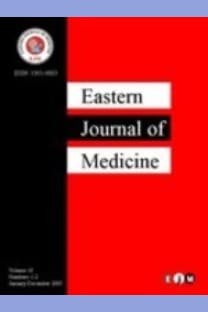The Significance of 4D Ultrasonography in Fetal Anomaly Screening
___
1. American Institute of Ultrasound in medicine. Acoustic output measurement standards for diagnostic ultrasound equipment. Laurel (MD): AIUM; 1998.2. Stark CR, Orleans M, Haverkamp AD, Murphy J. Short- and long-term risks after exposure to diagnostic ultrasound in utero. Obstet Gynecol 1984; 63: 194-200.
3. Kurjak A, Azumendi G, Andonotopo W, Salihagic-Kadic A. Three- and four-dimensional ultrasonography for the structural and functional evaluation of the fetal face. Am J Obstet Gynecol 2007; 196: 16-28.
4. Pretorius DH, House M, Nelson TR, Hollenbach KA. Evaluation of normal and abnormal lips in fetuses: comparison between three- and two-dimensional sonography. AJR Am J Roentgenol 1995; 165: 1233-1237.
5. Tonni G, Centini G, Rosignoli L. Prenatal screening for fetal face and clefting in a prospective study on low-risk population: can 3- and 4-dimensional ultrasound enhance visualization and detection rate? Oral Surg Oral Med Oral Pathol Oral Radiol Endod 2005; 100: 420-426.
6. Merz E, Welter C. 2D and 3D Ultrasound in the evaluation of normal and abnormal fetal anatomy in the second and third trimesters in a level III center. Ultraschall Med 2005; 26: 9-16.
7. Merz E, Abramowicz JS. 3D/4D ultrasound in prenatal diagnosis: is it time for routine use? Clin Obstet Gynecol 2012; 55: 336-351.
8. Gonçalves LF, Nien JK, Espinoza J, et al. What does 2-dimensional imaging add to 3- and 4- dimensional obstetric ultrasonography? J Ultrasound Med 2006; 25: 691-699.
9. Öcal DF, Nas T, Güler I. The place of fourdimensional ultrasound in evaluating fetal anomalies. Ir J Med Sci 2015; 184: 607-612
.10. Merz E, Bahlmann F, Weber G. Volume scanning in the evaluation of fetal malformations: a new dimension in prenatal diagnosis. Ultrasound Obstet Gynecol 1995; 5: 222-227.
11. Michailidis GD, Papageorgiou P, Economides DL. Assessment of fetal anatomy in the first trimester using two- and three-dimensional ultrasound. Br J Radiol 2002; 75: 215-219.
12. Yagel S, Cohen SM, Messing B, Valsky DV. Three-dimensional and four-dimensional ultrasound applications in fetal medicine. Curr Opin Obstet Gynecol 2009; 21: 167-174.
13. Dashe JS, McIntire DD, Twickler DM. Maternal obesity limits the ultrasound evaluation of fetal anatomy. J Ultrasound Med 2009; 28: 1025- 1030.
14. Andonotopo W, Kurjak A. The assessment of fetal behavior of growth restricted fetuses by 4D sonography. J Perinat Med 2006; 34(6): 471- 478.
- ISSN: 1301-0883
- Yayın Aralığı: 4
- Başlangıç: 1996
- Yayıncı: ERBİL KARAMAN
Sezai ÖZKAN, Cihan ADANAS, Ferhat DANIŞMAN
Mert Gökay EROĞLU, Gündüz Şekip BAYIRLI
Survivin expression may affect the neoadjuvant chemotherapy response in breast cancer patients
Zehra ER, HADİCE ELİF PEŞTERELİ, Lema TAVLI, Hakan BOZCUK, GÜLGÜN ERDOĞAN, HACI HASAN ESEN, MEHMET ARTAÇ, LEVENT KORKMAZ, Şeyda GÜNDÜZ, MUSTAFA KARAAĞAÇ, Sinem DEMİRCİOĞLU
Unusual complication of stent placement in the treatment of coarctation
Serhat KOCA, Ayşenur PAÇ, Vedat KAVURT, Ajda MIHÇIOĞLU, Denizhan BAĞRUL
HARUN ARSLAN, Zülküf AKDEMİR, Alpaslan YAVUZ, Necat İSLAMOĞLU, SEBAHATTİN ÇELİK, MESUT ÖZGÖKÇE, ABDUSSAMET BATUR, HÜSEYİN AKDENİZ, Harun Egemen TOLUNAY
Effect of postmenopausal strontium ranelate treatment on oxidative stress in rat skin tissue
MEHMET BERKÖZ, Özgün SAĞIR, SERAP YALIN, ÜLKÜ ÇÖMELEKOĞLU, FATMA SÖĞÜT, Pelin EROĞLU
Congenital hypothyroidism in Axenfeld-Rieger syndrome
İSMAİL ÇAĞATAY ÇAĞLAR, MUHAMMED BATUR, ERBİL SEVEN, SEREK TEKİN, TEKİN YAŞAR
ÖMER EKİNCİ, ALİ DOĞAN, CENGİZ DEMİR
The role of paroxysmal nocturnal hemoglobinuria in idiopathic habitual abortion
Yaren DİRİK, ÖMER EKİNCİ, Osman KARA, Deniz DİRİK, ALİ DOĞAN, CENGİZ DEMİR
